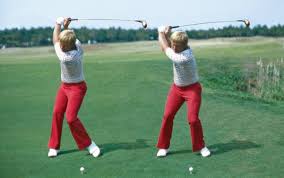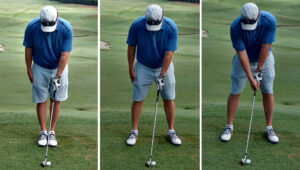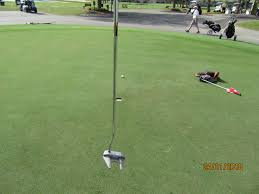The pros all swing with a straight leading arm in their backswing and downswing for more power and distance. Aging bodies lose their flexibility for a full backswing so you better find a way to “cheat” your swing to improve your body rotation. You may not be able to hit your drives 300 yards but you can certainly add 30 to 50 yards to your drives by making a few adjustments.
Clay at Top Speed Golf suggested some of the following tricks for more body rotation in his blog. Jack Nicklaus and Arnold Palmer figured these tricks out well before the end of their careers.

On the left Jack lifts his leading foot to allow for more backswing and then on the right he shifts forward with is leading foot to force the transfer of his weight at the start of the downswing.
1/ Lift your leading heal in your backswing to allow more rotation. You don’t see the pros doing this as they want to coil their bodies during the backswing. Jack Nicklaus always used the heal lift in his swing and he used the same trick during the ceremonial tee shot this year at the Masters.
2/ Exercise and stretch your shoulders to allow for a high backswing so that you can loop down and up the slot (for more power) the way that Jim McLean and so many others recommend.
3/ Rotate your head back so that you can see your ball with your leading eye during your setup. Yes, Jack did this throughout his career. This allows you to rotate your shoulders a little more during your backswing and really forces you to keep your leading eye ball on the ball (even during your down swing).
4/ Try a takeaway waggle the way so many pros are adding motion before their swing (like Rickie Fowler, Mike Weir and Michelle Wi). When you make the Weir Waggle, just leave my head rotated slightly (the way Jack does) with your leading eye firmly focused on your ball. This is another way to hold your head rotation during your backswing (as described in #3).
5/ When you setup make sure that your trailing foot is rotated back to assist in your backswing rotation and rotate your leading foot 45 degrees forward to help you complete the finish of your swing. Flaring your feet make it easier to rotation back and then forward.
6/ Finish your follow-through with the butt of your shaft pointing outside of your target line. This will force you to avoid leaving the face of your club open at the point of impact. [You need to do this to avoid slicing your shots.]
All of these “cheats” will help with your body rotation. Don’t depend on your arms to power your swing. Power comes from shoulder and hip rotation in the backswing followed by hip and shoulder rotation as you downswing and follow-through. Practice with your GOLFSTR+ to help you generated rotation with a straight leading arm in your backswing and down to your point of impact. Buy one today at www.golfstr.com







 Overpowering your swing never generates the best results. A little less ummph is the answer. When you take a less lofted club and swing at 90% you will improve your direction and distance control. Choking down on a less lofted club and keeping your swing at 90% is also a good plan. If you plan to swing a club at a much slower swing, you will most likely impact your ball with an open face on your club and you will not finish your swing as your ball slices away from your target line. A very slow swing can mess up the physical sequence of your swing.
Overpowering your swing never generates the best results. A little less ummph is the answer. When you take a less lofted club and swing at 90% you will improve your direction and distance control. Choking down on a less lofted club and keeping your swing at 90% is also a good plan. If you plan to swing a club at a much slower swing, you will most likely impact your ball with an open face on your club and you will not finish your swing as your ball slices away from your target line. A very slow swing can mess up the physical sequence of your swing.